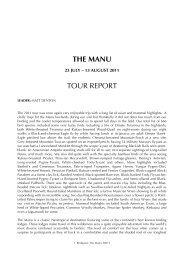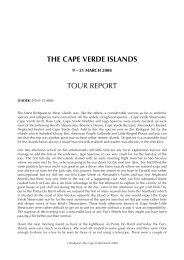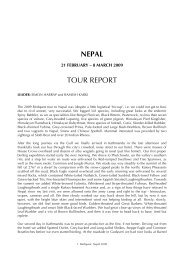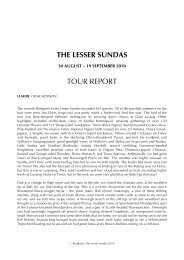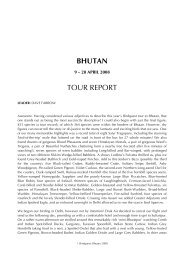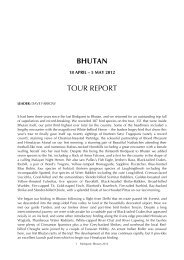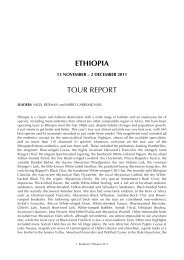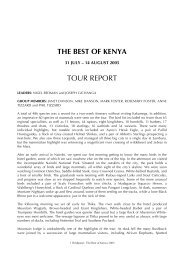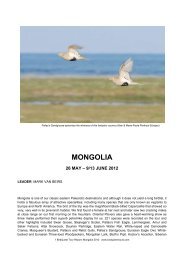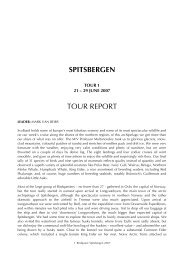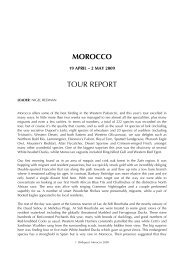Download Full Tour Report 3262kb - Birdquest
Download Full Tour Report 3262kb - Birdquest
Download Full Tour Report 3262kb - Birdquest
Create successful ePaper yourself
Turn your PDF publications into a flip-book with our unique Google optimized e-Paper software.
ecorded: up to eight Chestnut-crested Antbirds, maybe 15 White-plumed Antbirds (several pairs with<br />
fledged young), five or six Bicoloured Antbirds, a pair of Reddish-winged Bare-eyes, a pair of Barbellied<br />
Woodcreepers, six White-chinned woodcreepers and eight or more Plain-brown<br />
Woodcreepers. This just goes to show how unpredictable this phenomena is, although it is still<br />
disappointing not to have found an antswarm on the tour.<br />
On our last morning in São Gabriel we searched for Yellow-throated Antwren for Noel. In no time we<br />
were enjoyed great views of a pair in a large canopy flock together with Spot-backed Antwren,<br />
Pygmy Antwren, Amazonian Antshrike, White-crowned Manakins, more Ringed Woodpeckers and a<br />
White-necked Puffbird before we had to head to the airport for our flight to Manaus. In the afternoon<br />
we headed to the Sumauma park a tiny 50ha fragment of rainforest within Manaus. This park is one<br />
of the best localities for the very local Pied Tamarin, a species restricted to the metropolitan area of<br />
Manaus and highly threatened. Indeed it is considered the most threatened of South America’s<br />
primates. It is now the subject of an intense breeding programme and conservation effort to secure a<br />
viable population and by coincidence has also been the subject of a recent BBC Wildlife programme<br />
on breeding programmes for endangered species. After walking the trails we did find and watch a<br />
troop of this very attractive primate for some time. We also found a Red Acouchy and a roosting<br />
Blackish Nightjar along with a number of other common urban birds that have filled the niches<br />
previously occupied by true rainforest species..<br />
The following morning we transferred to the Anavilhanas Jungle lodge. While crossing the Rio Negro<br />
we saw a single Grey river Dolphin or Tucuxi. We then arrived late morning at the lodge. In the<br />
afternoon we found the pallens form of Snethlage’s Tody-Tyrant and the magnificent Yellow-crowned<br />
Manakins around the lodge. Our afternoon trip took us out to the islands in the archipelago. Our first<br />
stop on a narrow river bank produced most of the specialities. The first to call was the lovely Ashbreasted<br />
Antbird, a pair of Black-chinned Antbirds, a superb pair of Black-crested Antshrike and a<br />
pair of Blackish-grey Antshrikes. With a little more work we also saw a few Buff-breasted Wrens and<br />
a pair of Klages’s Antwrens. Previously thought to be restricted to this archipelago it is now found<br />
more widely in suitable habitat along many of the larger rivers in Brazilian Amazonia. Along the river<br />
we then found a group of Green-tailed Jacamars, several Black-fronted Nunbirds, a couple of Greychested<br />
Greenlets and a pair of Leaden Antwrens. Exploring the narrow channels that make up the<br />
archipelago we saw a few Bare-necked Fruitcrows, a male Amazonian Umbrellabird, a few Festive<br />
Parrots, several Muscovy Ducks and a Grey-headed Kite. Also at one site we heard maybe three<br />
Lesser Crestless Curassows, although they are notoriously difficult to see when booming. Exploring<br />
the entrance track and terra firma trails at the lodge we worked through a number of sub-canopy and<br />
canopy flocks finding a number of new species including White-shouldered Antshrike, Black-faced<br />
Antbird and Rufous-tailed Xenops. The canopy flocks here were very active and we saw good<br />
numbers of tanagers, dacnises, honeycreepers and woodcreepers before we had to head back to the<br />
lodge for lunch and our return to Manaus.<br />
The following morning we were at the port at 5am to catch our speedboat to Careiro on the south<br />
bank. In no time we were heading south along the Porto Velho road. Our breakfast stop was alive<br />
with birds and we quickly found a pair of Scarlet Macaws, dozens of Festive Parrots, Tui and Canarywinged<br />
Parakeets and quite a number of Short-tailed Parrots. We then began our search for the<br />
splendid Glossy Antshrike which we duly found and enjoyed superb views of. We then added<br />
hundreds of Black-bellied Whistling-Ducks, Muscovy Duck, Anhinga, Rufescent Tiger Heron, a few<br />
Hoatzins, a pair of Horned Screamers, a Great black Hawk, Limpkin and hundreds of egrets and<br />
herons. While enjoying a strong coffee we saw an adult Slender-billed Kite fly low over the road. In<br />
the more open cecropia woodlands we found a few Bicoloured Conebills, Yellow-chinned Spinetails,<br />
a single Brownish Elaenia, a pair of Masked Tityras, Hooded Tanagers and a Chestnut-crowned<br />
Becard. Nearer to Careiro we saw a single Buff-necked Ibis which was very unusual for the area. It<br />
was then time to head back to Manaus and our onward flights home, or to Roraima.<br />
6 <strong>Birdquest</strong>: Amazonian Brazil 2011




